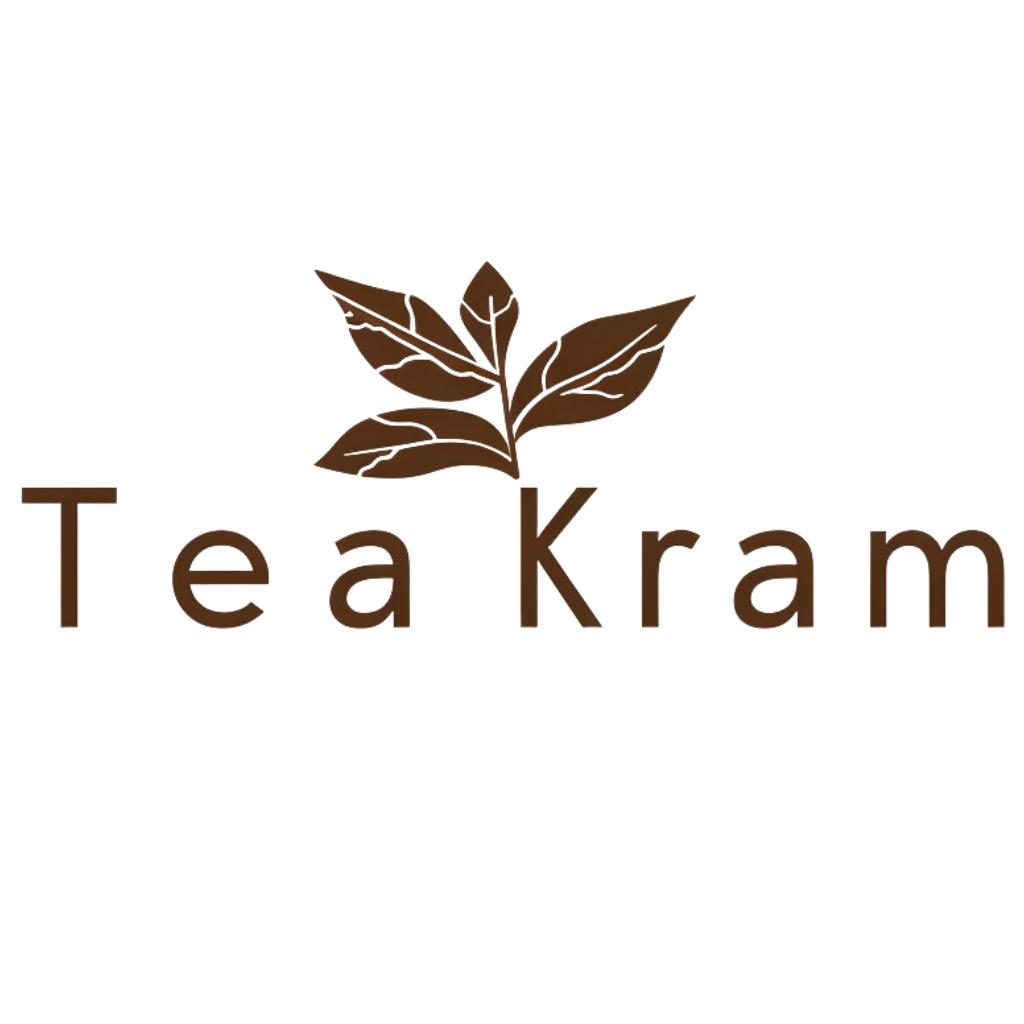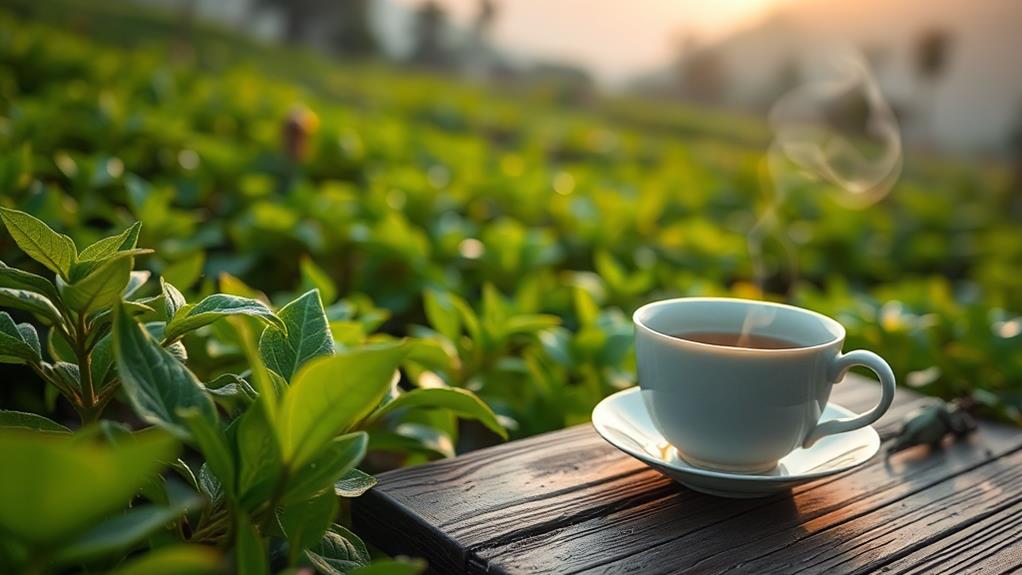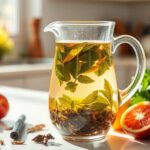Oolong tea is a fascinating beverage that combines the best of green and black teas. With a flavor profile that dances between floral and fruity notes, it's both invigorating and complex. Its color can range from greenish-yellow to deep brown, depending on how it's processed. This tea has moderate caffeine, giving you a gentle energy boost, while being rich in antioxidants, which help with digestion and hydration. Originating in China, oolong has a rich history and is enjoyed around the globe today. If you're curious about its health benefits and unique varieties, there's plenty more to discover!
Overview of Oolong Tea
Oolong tea, with its unique balance between green and black tea, offers a distinct flavor profile that many tea enthusiasts adore. This semi-oxidized tea sits perfectly between the two, presenting a delightful range of tastes and aromas. You'll find floral notes mingling with hints of fruit, making each sip an exploration of flavors.
Plus, the color of oolong can vary from greenish-yellow to dark brown, depending on how it's processed, which adds to its charm. Green tea's cultural significance complements the enjoyment of oolong, as both teas are steeped in rich traditions.
When you brew oolong, you'll notice the leaves unfurl beautifully, revealing their complex nature. The infusion can be steeped multiple times, each time releasing new flavors. With its moderate caffeine content, oolong provides a gentle energy boost, perfect for your afternoon pick-me-up.
Oolong tea isn't just about taste; it's rich in antioxidants, which can help support your overall health. Many people enjoy it for its potential benefits, like aiding digestion and promoting hydration.
As you immerse yourself in the world of oolong, you'll discover a tea that's not only delicious but also innovative in how it connects tradition with modern wellness trends. Whether you're a casual drinker or a budding connoisseur, oolong tea is sure to impress!
History and Origins
The rich history of oolong tea traces back to China, where it was first cultivated in the Fujian province over a thousand years ago. Imagine sipping a drink that has traveled through centuries!
Oolong tea emerged as a vibrant part of Chinese culture, often enjoyed in elaborate tea ceremonies. These ceremonies celebrated harmony and artistry, showcasing the beauty of tea drinking.
The name "oolong" means "black dragon," which reflects its unique and sometimes mysterious flavors. Curiously, the methods for crafting oolong have evolved, blending ancient traditions with modern innovations.
As tea enthusiasts, you might appreciate how oolong offers a delightful balance between green and black teas, creating a flavor profile that's both complex and invigorating.
Throughout history, oolong tea spread beyond China, influencing tea cultures in places like Taiwan and even parts of the West.
You'll find that each region has its own twist on this beloved beverage, making it a global treasure. As you explore the world of oolong, remember that you're partaking in a tradition that's rich with stories, innovation, and endless possibilities.
Production Process
While you might be familiar with the enjoyment of oolong tea, the production process behind it's where the real magic happens. This fascinating journey transforms fresh leaves into the aromatic brew you love, reminiscent of the intricate process of brewing green tea and its unique flavor profiles.
Here's how it typically goes down:
- Harvesting: Skilled workers carefully pick the tea leaves, often selecting only the youngest buds for the best flavor.
- Withering: The leaves are spread out to wilt slightly, allowing moisture to escape and preparing them for the next step.
- Oxidation: This is where the fun begins! Leaves are gently rolled, promoting oxidation, which develops their unique flavors and aromas.
- Fixation: The oxidized leaves are heated to stop the process, locking in those delightful characteristics.
- Drying: Finally, the leaves are dried to remove any remaining moisture, ensuring your tea stays fresh.
Each of these steps is essential in shaping the final product.
As you sip your cup, remember the artistry and innovation involved in crafting oolong tea. Embrace this knowledge, and you'll enjoy your tea even more!
Flavor Profiles and Varieties
After understanding the intricate production process, it's time to investigate the diverse flavor profiles and varieties that make oolong tea so enchanting. Each type of oolong offers a unique taste experience, ranging from floral and fruity to rich and roasted.
You might love the light, aromatic notes of a Tie Guan Yin, often described as a delicate mix of orchid and cream. On the other hand, a darker oolong, like Wuyi Rock, presents a bold flavor with hints of caramel and stone fruits, perfect for those who enjoy a deeper taste.
For those interested in the health benefits, explore the health advantages of oolong tea that can enhance your overall well-being.
As you explore the world of oolong, you'll find that brewing methods can also influence the flavor. Steeping time and water temperature play essential roles in extracting the essence of the leaves.
Experimenting with different parameters can lead to surprising discoveries, sparking your creativity.
You'll also encounter regional varieties, each reflecting its terroir, which adds yet another layer to your tasting journey.
Whether you're sipping a fragrant cup on a lazy afternoon or hosting a tea tasting with friends, oolong tea has something for everyone, inviting you to explore and enjoy its delightful spectrum of flavors.
Health Benefits and Uses
Oolong tea isn't just a flavorful indulgence; it offers a range of health benefits that can enhance your well-being. This unique tea straddles the line between green and black tea, and its health properties might just surprise you.
Here are a few reasons to contemplate adding oolong tea to your daily routine:
- Boosts metabolism: Oolong can help increase fat burning, making it a great addition to your weight management efforts. Regular consumption can also reduce chronic disease risk, contributing to long-term health goals. unique health properties
- Rich in antioxidants: These compounds help fight free radicals in your body, supporting overall health.
- Improves mental alertness: A cup of oolong can sharpen your focus and keep your mind clear throughout the day.
- Supports heart health: Regular consumption may lower cholesterol levels, promoting better cardiovascular health.
- Enhances skin health: Oolong tea is believed to improve skin conditions, giving you a healthy glow.
FAQ
How Do I Brew the Perfect Cup of Oolong Tea?
To brew the perfect cup of oolong tea, you'll want to use water just below boiling, steep for 3-5 minutes, and experiment with leaf quantity. It's all about finding your ideal balance and flavor.
Can Oolong Tea Be Enjoyed Cold or Iced?
Absolutely, you can savor oolong tea cold or iced! Picture a revitalizing glass filled with amber-hued tea, ice glistening, and subtle floral notes dancing on your palate—it's a delightful twist that invigorates your senses.
What Are the Best Food Pairings With Oolong Tea?
When enjoying oolong tea, pair it with savory dishes like grilled seafood, roasted duck, or spicy Asian cuisine. Its complex flavors complement these foods, enhancing your dining experience and inviting exciting culinary adventures.
How Does Oolong Tea Compare to Green and Black Teas?
Oolong tea sits between green and black teas in oxidation, offering a unique flavor profile. You'll find its rich complexity enticing, providing a smoother taste than green and a lighter touch than robust black teas.
Is Oolong Tea Safe for Pregnant Women or Children?
Charting the tea landscape, oolong's like a winding river. It's generally safe for pregnant women and children in moderation, but you should consult a healthcare professional to guarantee it fits your unique health journey.
Final Thoughts
In the world of tea, oolong stands out like a vibrant sunset, blending the best of green and black teas. With its rich history, intricate production, and unique flavor profiles, oolong isn't just a drink; it's an experience. Whether you're sipping a floral cup or a toasty brew, you're embracing a tradition that spans centuries. So, next time you steep a cup, take a moment to appreciate the artistry behind every sip. Your taste buds will thank you!



